Katherine Sabbath shares how to make (and decorate) a vintage buttercream cake
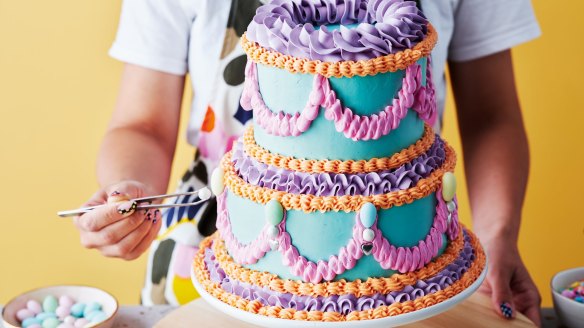
Vintage buttercream-style cakes have been gaining popularity over the past few years and I personally love anything with a retro aesthetic. You may have seen them featured on cool social media accounts, online magazines and blogs but have no idea how to find a local cake artist to make one for you. Well, I'm glad you've asked, because here's how you can make your own! Vintage buttercream is so open to different variations that it makes cake decorating approachable to all – my interpretation comes with modern pastel colours and a satisfying amount of kitsch factor. The more contrasting the colours, the better!
Serves 30
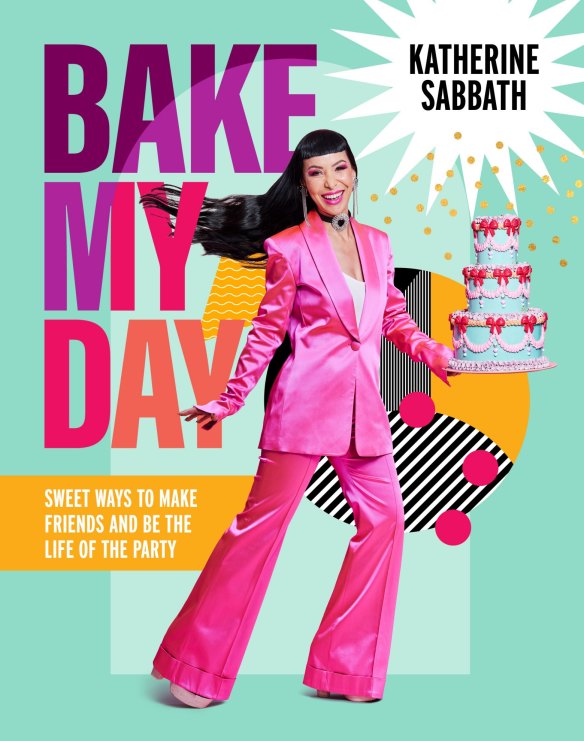
Chocolate sponge cake
INGREDIENTS
For the 20cm tier
- 1¾ cups (260g) self-raising cake flour or self-raising flour
- ½ cup (55g) Dutch cocoa powder
- 280g unsalted butter, at room temperature
- 1¼ cups (275g) caster sugar
- 5 large eggs, at room temperature
For the 13cm tier
- 1 cup (150g) self-raising cake flour or self-raising flour
- ¼ cup (30g) Dutch cocoa powder
- 140g unsalted butter, at room temperature
- ⅔ cup (150g) caster sugar
- 3 large eggs, at room temperature
METHOD
- To bake the 20cm cake tier, preheat the oven to 160C fan-forced (180C conventional). Grease two 20cm round cake tins, at least 8cm deep, and line the bases and sides with baking paper.
- Sift together the flour and cocoa in a medium bowl.
- Using a hand-held mixer or a stand mixer fitted with the paddle attachment, beat the butter and sugar on medium speed for 3 minutes, or until light and fluffy. Add the eggs one at a time, and beat until fluffy.
- Fold through the sifted dry ingredients, until combined.
- Divide the mixture evenly between the two tins. Level the surface using a spatula or the back of a spoon.
- Bake for 30 minutes, or until the tops of the cakes spring back when gently pressed. Remove from the oven and allow to cool for 10 minutes, before carefully turning out onto a baking rack to cool completely.
- Repeat this process to make the top tier of the cake, using two 13cm round cake tins, at least 8cm deep. Bake for 20 minutes, or until the tops of the cakes spring back when gently pressed. Remove from the oven and allow to cool for 10 minutes, before carefully turning out onto a baking rack to cool completely.
- Once cooled, use a cake leveller or a long, thin knife to carefully divide the four cakes into two even layers each. You'll now have eight cake layers. Cover with plastic wrap and set aside until assembly.
Salted caramel Swiss meringue buttercream
INGREDIENTS
- 3 cups (660g) caster sugar
- 16 large egg whites (pasteurised egg whites are available in cartons at most major supermarkets), chilled
- 900g unsalted butter, softened to a spreadable consistency
- 1 tsp vanilla bean paste
- 310g salted caramel or dulce de leche (store-bought is just fine)
- teal, pink, violet and orange gel paste food colouring
METHOD
- Place the sugar and egg whites in a heatproof glass bowl. Set the bowl over a saucepan of gently simmering water, and whisk until the sugar has dissolved and the egg whites are slightly warm to the touch (at least 40C). (You can omit this step entirely if you are using pasteurised egg whites, and instead, simply place the sugar and egg whites directly into the mixer.)
- Transfer the mixture into the bowl of a stand mixer fitted with the whisk attachment. Whisk on high speed until the mixture has formed stiff and glossy peaks, around 10-15 minutes.
- Switch to the paddle attachment. Add the butter in thirds, and beat on high speed after each addition until incorporated. Don't be alarmed if the buttercream appears curdled – it will become light and fluffy again with continued beating for around 2-3 minutes (I absolutely promise!). Add the vanilla bean paste and beat until just combined.
- Divide the buttercream into thirds. Flavour one third with the caramel/dulce de leche and thoroughly mix through.
- Tint another third by mixing in the teal colouring until the desired shade is achieved.
- Divide the remaining third into three smaller portions and tint each one separately: pink, violet and orange.
- Cover the bowls with plastic wrap and set aside at room temperature in a cool environment until needed.
Assembly and decoration
INGREDIENTS AND EQUIPMENT
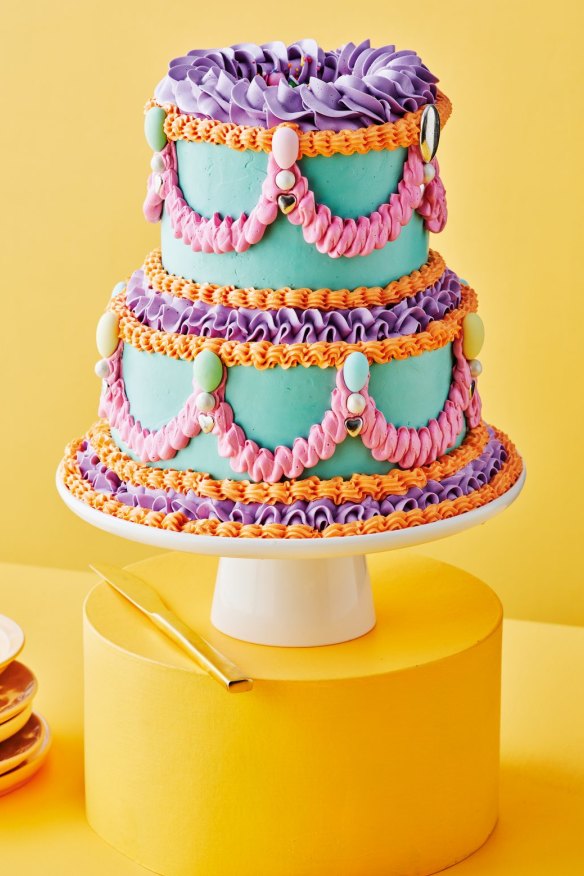
- 5 cake dowels (available from cake decorating stores or online)
- 10cm cardboard cake board
- medium piping bag fitted with a 1cm tear-shaped (ruffling) tip
- large piping bag fitted with a 2cm star tip
- medium piping bag fitted with a 1cm star tip
- heart-shaped silver cachous
- sugared almonds
- white candy-coated chocolate pearls
- 3 tsp rainbow sprinkles (I used a sprinkle mix of confetti sprinkles and rainbow jimmies)
TO ASSEMBLE
- Working on a cake turntable, secure the bottom layer of the 20cm cake onto a cake board with a small dollop of caramel buttercream and then gently twist in place.
- Use an offset spatula to spread a 5mm layer of caramel buttercream right to the edge of the cake.
- Repeat the process with the remaining 20cm cake layers, leaving the final top layer uncovered. If the buttercream filling is getting too soft in between layering, place the cake in the refrigerator for a short time to firm the cake up and provide stability (you may have to do this a few times).
- Use an offset spatula to gently crumb-coat the cake with a thin layer of the teal buttercream. Chill the cake in the refrigerator for 10-20 minutes; this will make it much easier to pipe and smooth the buttercream onto the outside.
- Apply another layer of teal buttercream to the chilled cake and use a cake scraper to smooth the side. Finally, use an offset spatula to smooth the top of the cake by gently pulling inwards from the outer edge of the cake into the centre, cleaning the excess ganache off the spatula with each scrape. Place the cake in the refrigerator until it is chilled, at least 1 hour, as it is much easier to work with a chilled cake with firm frosting.
- 6 Once the layers for the bottom tier are assembled, it's time to prepare the placement of the top tier. I usually just estimate where the cake on top will sit but you can be more precise and mark an outline by using a cake tin or a round of cardboard the same size as the smaller tier. Place it in the middle of the cake and lightly mark the outline with a toothpick or a knife.
- Take one dowel and insert it into the cake inside the markings. Mark the height of the cake with your thumb, take the dowel out, mark it with a pen and cut with scissors or a serrated knife. Use that dowel as a guide to cut the remaining three dowels. Insert the four trimmed dowels into the cake, well inside where the next cake tier will sit, and use a dowel offcut to push them right down into the cake.
- Place one of the smaller cake layers on the 10cm cardboard cake board. Repeat steps 3–5 to fill, frost and chill the cakes until firm.
- To place the second tier on top of the first, use a large metal spatula or cake lifter to help carefully guide the cake into the middle, within the outline you have marked.
- This step is optional, but particularly handy if you are going to transport or carry your cake. To secure the cakes together and make sure the tiers won't slide off, take a big wooden dowel, slightly shorter than the cake. Sharpen one end of the dowel with a clean sharpener and, with the help of a clean hammer, carefully drive it down into all the layers until it reaches the base, using a dowel offcut to help push it all the way down. Use buttercream to mask the hole on top as well as cover any gaps or blemishes between the tiers.
TO DECORATE
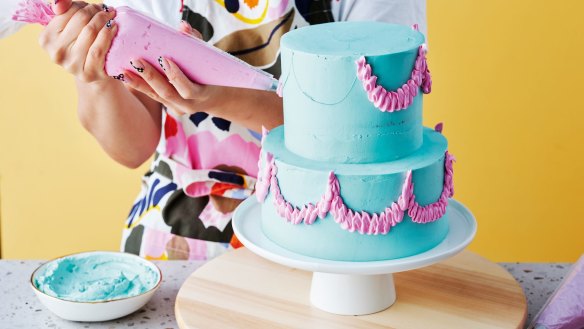
11. Using a medium piping bag fitted with a 1cm ruffling tip, pipe pink buttercream ruffled "curtains" along the outside of both tiers of the cake (I mark the outline with a toothpick first to help guide me).
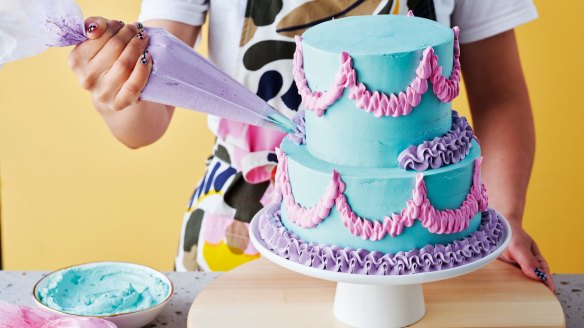
12. Using a large piping bag fitted with a 2cm star piping tip, pipe a violet buttercream border along the bottom of each tier and the top of the upper tier.
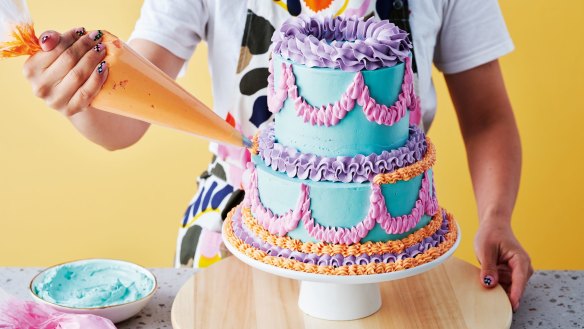
13. Using a medium piping bag fitted with a 1cm star tip, fill in the remaining orange buttercream borders.
14. Finish decorating the cake using silver cachous, sugared almonds and candy-coated chocolate pearls.
15. Decorate the top of the cake (inside the top circular buttercream border) with rainbow sprinkles.
Storage tips:
- This cake is best served at room temperature. It can be stored in an airtight container in the fridge for up to 1 week or frozen for up to 1 month.
- You can bake the cakes 1 day in advance. Tightly cover them with plastic wrap and store at room temperature.
- The Swiss meringue buttercream can also be made ahead of time. Cover the bowl with plastic wrap and set aside in a cool, dry place until needed. You can refrigerate this buttercream for up to 10 days or freeze for up to 2 months. Thaw frozen buttercream overnight in the refrigerator, then bring to room temperature (gently reheat in the microwave in 20-second bursts if needed). Beat the buttercream on low speed until smooth before applying to your cake.
This is an edited extract from Bake My Day by Katherine Sabbath, photography by Jeremy Simons. Murdoch Books, RRP $45.00. Buy now